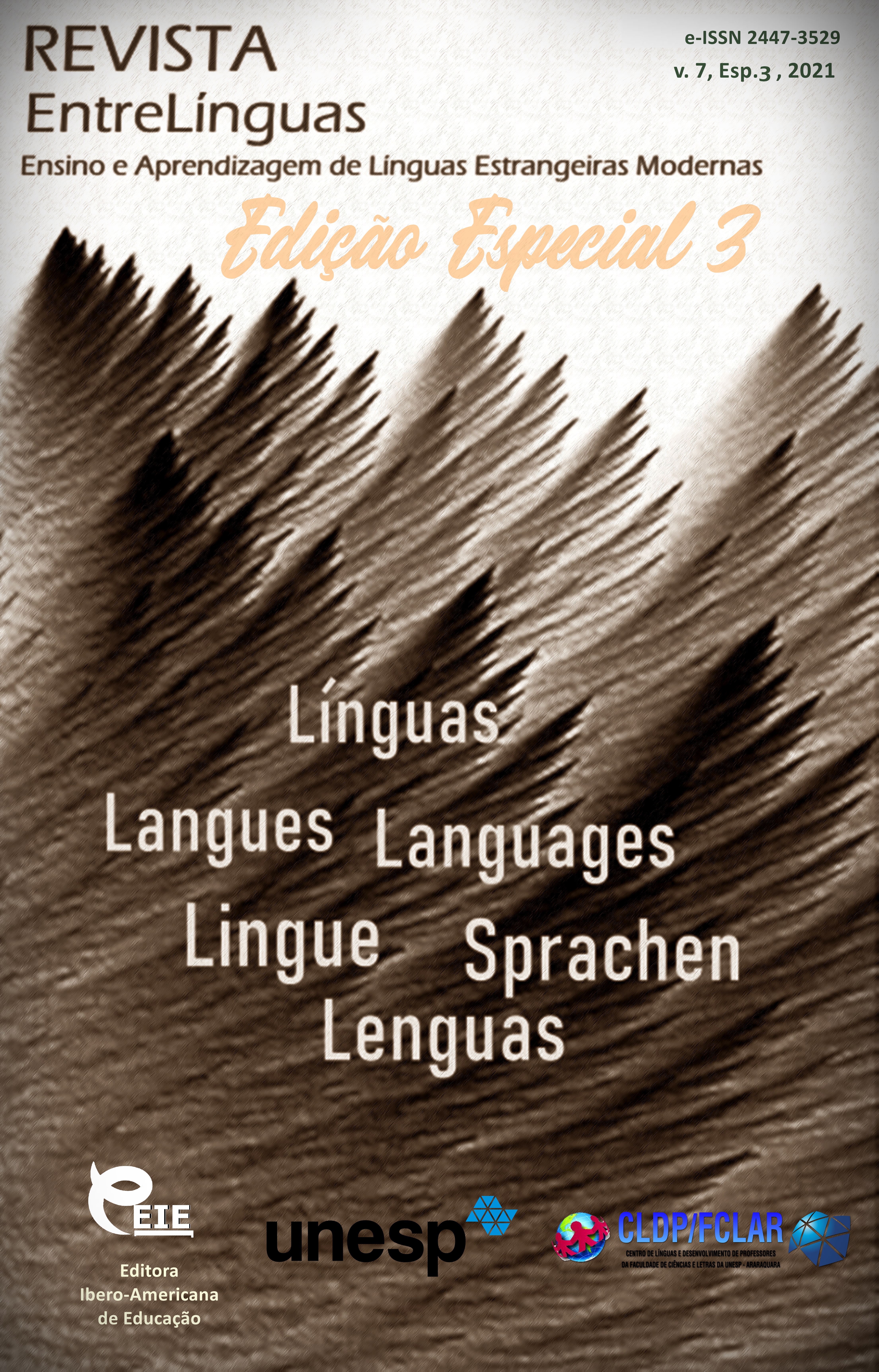Técnicas tradicionais e digitais para trabalhar com material léxico em aulas de inglês
DOI:
https://doi.org/10.29051/el.v7iesp.3.15731Palavras-chave:
Comunicação, Língua estrangeira, Alunos, Discurso, Competência comunicativaResumo
A relevância deste estudo se deve ao fato de que a habilidade lexical é parte integrante de todos os tipos de atividade da fala, cuja formação, aprimoramento e desenvolvimento é a principal tarefa do ensino de uma língua estrangeira, nomeadamente o Inglês. Os autores enfocam a necessidade de um bom conhecimento do vocabulário para o desenvolvimento bem-sucedido da competência comunicativa dos alunos em um mundo globalizado. O objetivo deste estudo é examinar o processo de formação de competências linguísticas no ensino de uma língua estrangeira e revelar quais técnicas são mais adequadas para os alunos pré-intermediários e intermediários com base na pesquisa realizada entre os alunos do primeiro ano da Universidade Federal de Kazan. Com base na análise de métodos eficazes para a introdução do vocabulário nas aulas de inglês, os autores identificaram 10 estratégias para a aprendizagem eficaz do vocabulário e compararam os métodos tradicionais e digitais de sua introdução e prática. Os autores deste artigo prestam atenção especial à experiência de ativar o aprendizado de um novo vocabulário nas aulas de inglês. Exemplos de exercícios lexicais típicos para cada estágio de trabalho com o vocabulário são sugeridos. São tiradas conclusões com base na pesquisa de 213 alunos.
Downloads
Referências
ABROSIMOVA, G. A. et al. Blended learning in university education. Humanities & Social Sciences Reviews, v. 7, n. 6, p. 6-10, 2019.
ANTONACCI, P. A.; O’CALLAGHAN, C. M. Promoting literacy development: research-based strategies for K-8 learners. California: SAGE Publications, Inc., 2011. 167 p.
BAUMANN, J.; WARE, W. E. Edwards, bumping into spicy, tasty words that catch your tongue: A formative experiment on vocabulary instruction. The Reading Teacher, n. 61, p. 108-122, 2007.
BUCKOWIECKI, E.M. Vocabulary instruction: advice to new teachers. New England Association Journal, v. 2, n. 42, p. 29-40, 2006.
COSKIE, T. L.; DAVIS, K. J. Word wall work: Supporting science talk. Science and Children, v. 46, n. 8, p. 56-58, 2009.
CUNNINGHAM, P. Phonic they use: words for reading and writing. 3. ed. New York: Longman-Addison Wesley, 2000. 232 p.
EREMEEVA, G. R. Dialogization of professional communication between students and lecturers. Journal of Organizational Culture, Communications and Conflict, n. 20, p. 128-134, 2016.
HARMON, J. M. et al. Interactive word walls: more than just reading the writing on walls. Journal of Adolescent & Adult Literacy, n. 52, p. 389-408, 2009.
HENRICHS, E. L. Interactive word walls and student perceptions of vocabulary. Texas State University, 2011. Available: https://digital.library.txstate.edu/handle/10877/2473. Access: 04 June 2020.
HILDEN, K.; JONES, J. Classroom word walls: is yours a tool or a decoration? Reading Today, v. 29, n. 4, p. 9-11, 2012.
JACKSON, J. K. Interactive, conceptual word walls: Transforming content vocabulary instruction one word at a time. International Research in Education, v. 2, n. 1, p. 37-46, 2014.
JACKSON, J.; NARVAEZ, R. Interactive word walls: create a tool to increase science vocabulary in five easy steps. Science and Children, v. 51, n. 1, p. 42-49, 2013.
KENT, M. A. The effect of systematic word wall instruction on the literacy achievement of first grade students. UMI No. 30558, 2006. 176 p.
KHUSAINOVA, R. R.; VALEEV, A. A. Technological aspect of the development of university students foreign language activities. Astra Salvensis, n. 6, p. 746-764, 2018.
KONDRATEVA, I.; SABIROVA, D.; PLOTNIKOVA, N. Subjectivity functions in reflexive and intercultural process of linguistic development. Cypriot Journal of Educational Sciences, v. 13, n. 4, p. 529-536, 2018.
KUVSHINOV, V. I. About work with vocabulary in school. Foreign Languages at School, n. 5, p. 20-24, 2015.
KUZNETSOVA, T. M. Stages of work on the word. Foreign Languages at School, n. 5, p. 88-94, 2011.
MAY, B. Will using a classroom word wall help students successfully learn high frequency words? Winona State University Anthology of k-12 language arts action research, ERIC document Reproduction Service, ED 494233. 2004.
ROGOVA, G. V. RABINOVICH, F. M.; SAKHAROV, T. E. Methods of teaching foreign languages in secondary school. Moscow: Education, 2011. 254 p.
SHAKIRZYANOVA, R. M.; ZAKIROVA, R. R. The creativity development of teenagers in leisure time. Humanities & Social Sciences Reviews, v. 7, n. 6, p. 76-80, 2019.
SOLOVYOVA, E. N. Methods of teaching foreign languages. Basic course of lectures / manual for students and teachers in ped. Universities. Moscow: Education, 2012. 321 p.
VALEEV, A. A. et al. Major areas of foreign language speech activity of university students improvement. Humanities & Social Sciences Reviews, v. 7, n. 6, p. 967-977, 2019.
YATES, P.; CUTHRELL, K.; ROSE, M. Out of the room and into the hall: making content word walls work. The Clearing House: A Journal of Educational Strategies Issues and Ideas, v. 84, n.1, p. 31-36, 2011.
Downloads
Publicado
Como Citar
Edição
Seção
Licença

Este trabalho está licenciado sob uma licença Creative Commons Attribution-NonCommercial-ShareAlike 4.0 International License.
Os manuscritos aceitos e publicados são de propriedade da Revista EntreLínguas. Os artigos publicados e as referências citadas na Revista EntreLínguas são de inteira responsabilidade de seus autores.
Transferência de direitos autorais – autorização para publicação
Caso o artigo submetido seja aprovado para publicação, já fica acordado que o(s) autor(es) autoriza(m) a UNESP a reproduzi-lo e publicá-lo na EntreLínguas, entendendo-se os termos “reprodução” e “publicação” conforme definição respectivamente dos incisos VI e I do artigo 5° da Lei 9610/98. O artigo poderá ser acessado pela rede mundial de computadores (Internet), sendo permitidas, a título gratuito, a consulta e a reprodução de exemplar do artigo para uso próprio de quem a consulta, desde que haja a citação ao texto consultado. Essa autorização de publicação 328 EntreLínguas, Araraquara, v. 1, n .2, p. 323-328, jul./dez. 2015 não tem limitação de tempo, ficando a UNESP responsável pela manutenção da identificação do(s) autor(es) do artigo. Os artigos publicados e as referências citadas na Revista EntreLínguas são de inteira responsabilidade de seus autores.











